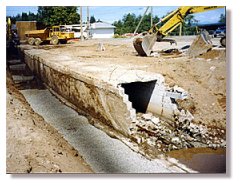The Cycle Comes
Around
By Dave Hadden
The muted burble of the tiny waterway seems insignificant, surrounded as it is by the
richness of the land. Yet in these tiny waters there are coho. Tiny ones to be sure, matching their
environment, but coho all the same - endangered coho. The importance of small creeks in the
cycle of the coho is well known. Coho spawn and rear in them. Without them there would be no
coho.
In 1963, a tall, skinny 18 year old carried concrete blocks from a pallet to the edge of
a ditch which crossed the property upon which a lumberyard was to be extended. Walls were
built up parallel to the ditch. The construction was capped and then filled in around and over the
ditch, forming a tunnel.

Back in 1963 this fish tunnel on Kingfisher
Creek was
built with the help of the Haig-
Brown Kingfisher Creek Society's
current
Secretary/Treasurer. This past week, it has
been decommisioned, while the same
man
works to provide habitat for the
fish it once carried.
That fall, when the rains came and the ditch ran full with water, the coho came again. They
swam through the tunnel, through a culvert under the Island Highway, and into the marsh which
once existed there. From there they swam through another culvert, passed behind the school and
entered the wooded area across from the Haig-Brown House. That ditch was Kingfisher Creek
and Roderick saw the coho.
|
He knew there weren't many. It was a tiny creek, yet coho came every year. Some
years more than others, but always some. He wondered how long coho would be able to make it
to their spawning beds. How long would the marsh serve as their nursery?
Nobody can know when the idea first came. Perhaps he was watching coho spawn,
amazed, as always, by the intensity of their work and the persistence of their presence. He spoke
with his neighbor Van Egan. Perhaps the creek could be saved, they thought, but it would require
relocating it away from the industrial area sure to expand where the creek then ran. They mulled
it over.
Sadly, Roderick passed before anything could be done, but the idea lived on, and
grew, and a society was formed. The first phase happened in 1984, when a new channel was
created which wound through the Haig-Brown property to the Campbell river. Coho found the
new channel and used it. As the old creek gradually disappeared, the new one became more
used.
It has taken 14 years to reach the position we are in now, and a comprehensive plan
is in place. This summer, a new channel will be
created which will encompass spawning and rearing habitat, and a
Stormwater Management Plan.
That 18 year old kid from 1963 is working on the project, sharing the dream of
Haig-Brown. That kid is me, now 53 and Secretary/Treasurer of the Society. I feel like I owe the
effort, if not to Haig-Brown then at least to the coho.
Top of page.
|

